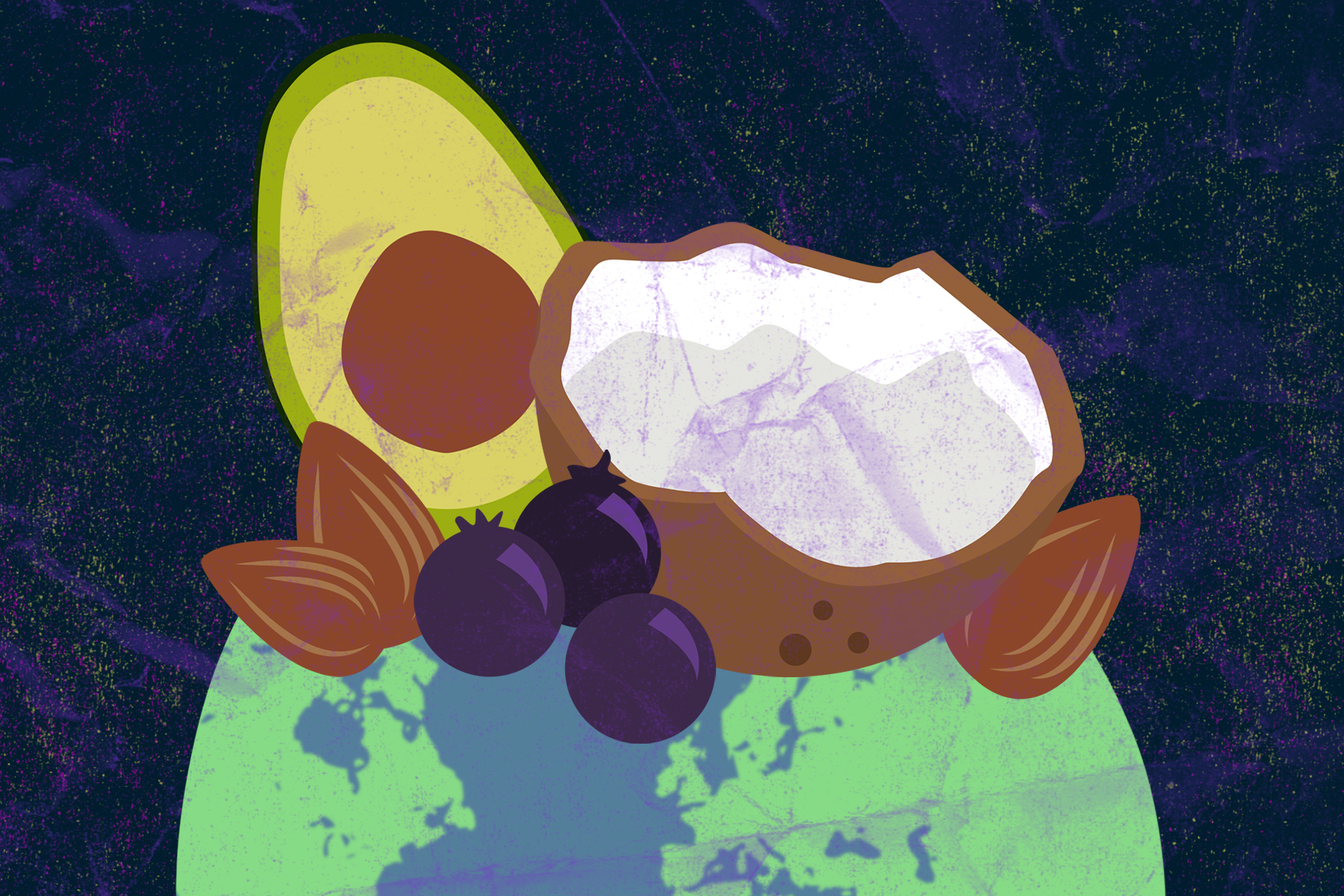Obesity is on the rise. So are diabetes, heart disease, cancer, high blood pressure, osteoporosis and myriad other diet-related chronic diseases. In fact, as of today, almost 70% of Americans are either obese or overweight, with many other countries rapidly following the U.S.’s example.
The problem is that those who are overweight or obese are at greater risk of these serious chronic diseases and illnesses, including COVID-19. You’ll die early: According to a Harvard medical study, for every five-unit increase in your BMI of 25.0 (a healthy BMI value), you’ll see a resulting 31% increase in the risk of premature death.
With those morbid statistics in mind, many have turned to what they believe is the “smart” solution to their diet problems: superfoods.
Superfoods are foods that are thought to have superior nutritional qualities, produced in an organic or “natural” way, and associated with the diets of Indigenous people or the diets of those in remote and “exotic” locations. Many of these foods are now popular in contemporary Western diets, such as avocados, quinoa and chia seeds, or uncommon ones like camu camu, goji berries or seaweed.
What distinguishes superfoods from other foods is the assumption that they are inherently naturally full of vitamins, minerals or macros. Although many of our “regular” foods like cereal or rice also have these health benefits, albeit fortified or nutritionally enhanced in production, it is the idea of “clean” and “organic” eating that is king. As a result, superfoods are seen as the more natural and “healthier” way to eat.
Indeed, these superfoods ARE extremely healthy (even Harvard agrees). They are staple foods, used for millennia by local cultures for their nutritious and disease-preventative qualities. These groups of people are often found to be some of the longest-living people on the planet. For instance, seaweed has been a long-standing part of Japanese people’s diets. Seaweed is high in calcium and iron and is one of the rare products that isn’t meat that provides the essential vitamin B12. As a result, it is a godsend for vegetarians and vegans. Paired with a diet rich in fresh fish and vegetables, it’s no wonder that Japan is known as the world’s most long-lived country. Quinoa, too, is a remarkable superfood, as the only plant that contains all essential amino acids, trace elements and vitamins. Did I mention that it’s gluten-free as well?
But the problem with superfoods is that they should not be considered as the “one-stop” solution for our country’s many health problems because that assumption could be potentially dangerous for our health.
Ingesting too much of a single food and consequently overdosing the specific mineral that it provides can inhibit your body’s absorption of other essential vitamins. Furthermore, you may not want to ingest too much of any specific mineral anyways — for example, the iodine present in seaweed is necessary for life, but consuming too much of it can cause iodine toxicity, which creates thyroid issues.
Furthermore, relying on these superfoods as a solution for our country’s obesity problem blinds us to the actual, systemic problems at hand: the poor nutrition resulting from convenient and cheap access to unhealthy fast food, an increase in sedentary living, ingloriously large portion sizes and a culture of accepting corpulence as the new normal. Restaurants tempt us with economical “value meals” that pack in a liter of sugar-laden drinks and fried foods in addition to your caloric bomb of a burger, and “supersizing” it to boot. The pressures of modern-day working mean eating out more, sitting more and exercising less. And when you can buy either a burger or an apple for a dollar, most would choose the burger, for financial reasons if not taste-wise.
So when companies market superfoods like some sort of magical diet pill, it only detracts from the fact that getting rid of obesity essentially requires a complete overhaul in the American-style way of living, for both the individual and the nation. Eating a salad with chia seeds is great, but it’s an ineffectual, tiny bandage on the gaping bullet wound that is the obesity epidemic.
Consider too, if you might just be feeding into marketing hype, especially if you are a consumer residing in high-income countries like the U.S. or in Europe, where demand from these countries sets a high market price for these superfoods. The high level of control over the economic value of these superfoods can lead to a boom-and-bust cycle for the local economies that grow these crops — meaning you, as the consumer, can make or break the economic livelihoods of these Indigenous communities.
For instance, the price of quinoa skyrocketed three-fold from 2006 to 2013 as America and Europe first discovered this new superfood. Although the scaremongering media reports that suggested that Bolivians and Peruvians could no longer afford quinoa were eventually debunked in a study in 2016, the fact still stands that prices fluctuated wildly in response to consumer demand for this superfood.
The problem is, what happens when the prices drop? When this superfood is out of fashion, and another one takes its place as the hot new thing? Or, when, seeking to take advantage of the high prices, other countries start growing the crop? Countries such as China, India, Nepal, the U.S. and Canada started to plant quinoa near the end of the food’s popularity cycle. As a result, the cost of quinoa started to fall in 2014, plummeting just as quickly as it had risen. By late 2015, the cost of quinoa was back to its original price in 2012, before the demand.
It wasn’t just the economies of local communities that were hurt. Ultimately, the environment pays the true cost of these superfoods. The demand for quinoa was focused on only a few of the over 3,000 different varieties of quinoa. This prompted farmers to abandon many of these varieties, decreasing the overall diversity in the crop. Monocropping is problematic because it encourages reliance on a single variety, and if that variety fails due to pests or infections, as the banana did in the past, you’ll have a rotten problem on your hands.
There’s also the issue of environmental degradation to consider. According to a study conducted on Bolivian farmers of quinoa, more than half said the quality of their soil has worsened when compared to before the quinoa boom. Monoculture of the crop and use of heavy machinery increased soil erosion and degradation, and the increase in cultivating quinoa means fewer farmers are herding llamas and alpacas, who naturally fertilize the soil with their manure.
There are other problems as well. Superfoods used to be either grown or harvested following traditional practices, on a low-scale and low-environmental-impact manner. Now, in order to meet the demand of high-income consumers — Western populations — they now have to be grown using intensive agriculture, huge plantation farms and heavy machinery. You can add deforestation, erosion and loss of biodiversity to your breakfast bowl as well.
Furthermore, in order for your acai or avocados to reach you, thousands of miles away from the farm, your superfood now has to be processed, packaged, transported, distributed, marketed and displayed — with each step emitting hundreds of tons of carbon dioxide and other greenhouse gases. In the case of acai berries, a popular ingredient for smoothie bowls, the pulp needs to be extracted, pureed, packaged and immediately frozen. And it has to stay perfectly frozen as it travels across the world to your smoothie, increasing its ecological footprint.
This isn’t a new phenomenon — the same environmental and social impacts also occurred in the past when Western countries developed a taste for coffee beans, cacao, coconuts and bananas.
If superfoods are to follow in the footsteps of these other global commodities, then progress needs to be made toward a sustainable superfood industry.
There need to be eco-conscious and sustainable ways to engage with superfoods so that you can responsibly incorporate them into your diet.
Firstly, and most importantly, consider if it is really necessary and if it will make a lasting change in your health. Are you simply feeding into the marketing hype? Does it meet some nutritional deficiency? Will you engage in actual, healthy practices that involve making conscious dietary swaps with this superfood? After all, the benefits of the modest avocado as a healthy fat are rendered moot when you’re scarfing it down on a greasy burger laden with bacon and cheese.
Most of the time, superfoods are promoted by food companies as a marketing ploy to plunder new market niches and drive artificial demand. They don’t always have a scientific basis for the food as a component of a healthy diet; instead, these companies focus on their “natural” origin and the “romantic” stories that link them to ancient civilizations.
Secondly, given that superfoods are in many cases grown and manufactured in countries far from where they are consumed, it’s difficult to know for sure whether what you’re eating was grown responsibly, or if it was the product of child labor. However, there will always be accessible certifications like “Rainforest Alliance” and “Fairtrade” to check if the products you’ve consumed have a sustainable, trackable origin.
Remember that you, as the consumer, have an incredible amount of power — it is your behavior that sets the price, sets the standards, and, ultimately, sets the standards for sustainability expectations. So, do your research.
Eating superfoods is a joy and a healthy, tasty decision, and it seems like they are here to stay. Just make sure to respect not only the communities of origin and the environment, but also your own health as well.

















